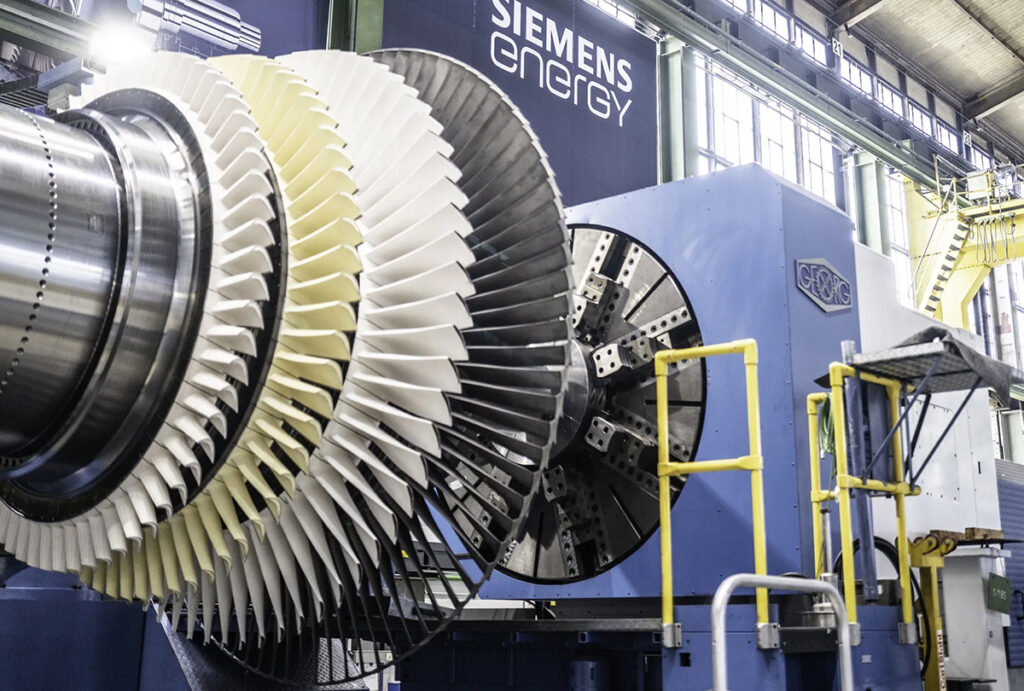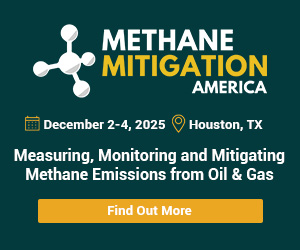By Akshat Rathi, Stephen Stapczynski, and Oscar Boyd
Booming electricity demand driven by AI is causing a shortage of gas turbines worldwide, Stephen Stapczynski and Akshat Rathi explain why on Zero podcast.

Gas turbine components, rotors and stators, tested at the Siemens Energy AG manufacturing plant in Berlin, Germany. Photographer: Nicolo Lanfranchi/Bloomberg
Rising power demand from data centers for artificial intelligence has led to a shortage of the gas turbines needed to generate electricity. This shortage might not seem the most obvious climate story, but it’s having impacts across the entire energy sector. This week on Zero, Bloomberg’s Stephen Stapczynski joins Akshat Rathi to look at what’s causing the bottleneck in gas turbines, if the shortage will make companies look to renewables or coal, and whether natural gas is really a “bridge” fuel.
Listen now, and subscribe on Apple, Spotify or YouTube to get new episodes of Zero every Thursday.
Our transcripts are generated by a combination of software and human editors, and may contain slight differences between the text and audio. Please confirm in audio before quoting in print.
Akshat Rathi 00:00
Welcome to Zero, I’m Akshat Rathi. This Week: Gas Turbines — A Blessing Or A Curse?
For the last year at Bloomberg Green, I’ve been investigating bottlenecks to our clean, electrified future. We’ve covered several different topics on Zero, from a lack of grid transformers to the shortage of skilled workers.
Today we’re going to be talking about something that might not have an immediately obvious climate benefit: gas turbines. Those spinning things that burn natural gas and turn a generator to produce electricity.
There’s a growing shortage of gas turbines. It used to take around 2 years to get a new one, now it takes up to five or more.
Advocates for gas call it a “transition fuel” – something that can fill the gap between burning coal and moving to a 100% carbon-free grid. That’s because for every kilowatt-hour of electricity produced from gas, it only releases half the amount of carbon dioxide as compared to coal.
Gas can also provide a useful and relatively cheap backup to renewables, allowing for more clean power to be built out quickly without worries of blackouts.
But there are also serious concerns about lock-in. Once someone spends billions of dollars building a gas power plant, they’ll want to run it for long enough that it can make a decent return on their investment.
Also, it’s worth noting that natural gas is mostly made of methane, which has 80 times the warming potential of C02. There’s a risk that, if methane leaks aren’t kept in check, then gas power plants can be as bad or worse than coal power plants.
Whether you believe gas is a blessing or curse for the energy transition, the shortage of gas turbines is causing serious delays and cancellations in the buildout of the electricity supply that businesses desperately need.
Joining me to discuss all this is Stephen Stapczynski, who edits energy stories and writes about natural gas for Bloomberg. He and I collaborated with our colleague Josh Saul to conduct a global investigation into the state of the gas turbine industry.
Today on Zero we look at what’s causing the bottleneck in gas turbines, whether the shortage will make companies look to renewables or go back to coal, and whether gas is really a bridge to the future, or the end goal for the fossil fuel industry.
Akshat Rathi 2:33
Stephen, welcome to the show.
Stephen Stapczynski 2:35
Thank you for having me.
Akshat Rathi 2:36
I consider you to be Bloomberg’s resident expert on natural gas. You nerd out about LNG tankers. You put out tiktoks, about crazy price swings, and there are lots of Simpsons characters in there on your charts. I also assume that sitting in Singapore, you have a set of binoculars that you use to see these bulbous ships go past right?
Stephen Stapczynski 3:00
Man, if I had a place in Sentosa, I would totally do that. But unfortunately, my view is just a bunch of buildings. But when I do go to the beach, I do look out for LNG ships and I see them.
Akshat Rathi 3:10
So it’s great to have you on Zero, and we are going to talk about a phenomena that you and I have both seen building up for some time now, but it has come to a crisis point. It’s the shortage of gas turbines. When did you first hear about it?
Stephen Stapczynski 3:25
You know, I’ve been reading reports about this for maybe a year, how there have been more gas turbine orders, and I actually didn’t pay very much attention to it, because I’ve been covering LNG at Bloomberg for over a decade, and for a long time gas turbines was one of the more boring parts of the industry. You would order your turbine, it would come 24 months later, usually, without fail. There would be no issues. But I was at an energy conference in India in February. And in India, they want to boost gas. They want to make it 15% of the energy mix by 2030, basically double where we are today. And so I would ask the utilities, what are you going to do? Your grid is mostly coal. Are you going to build some new gas fired power plants to try to boost those numbers and hit the 2030 goal for Modi? And the utilities looked at me and they said, ‘we can’t afford that.’ And I said, ‘why not? Is it because the gas was too expensive?’ You know, the invasion of Ukraine, Russia kind of shocked the market and prices jumped. And they said, ‘Well, that’s one issue, but another is gas fired power plants are just too expensive for us to build at the moment. It makes far more sense for us to look at coal or even in some cases, renewables.’ I was a little bit surprised by that. I didn’t know gas power plants got so expensive, and they’re on the front lines, probably one of the more price sensitive buyers. So that got me kind of looking into it, and I realized that there was something happening in the market, from Asia to the US to Europe. People weren’t getting the turbines that they wanted quickly, and it was costing them far more money.
Akshat Rathi 4:49
Yeah, so it is a strange thing, because if you are not the nerd that is Steven who looks at LNG prices daily, you’re going to be like: Hold on a minute, there was the Russia, Ukraine war that caused this huge gas spike. People were struggling to get gas, and now we have gone and swung the other way, where it’s not about gas shortages, it’s about the shortage of gas turbines. How does that happen?
Stephen Stapczynski 5:16
First off, I think we need to explain very briefly what a gas turbine is, right? It’s the heart of a power plant. So if you want to generate electricity, you have to build a power plant and essentially turn a turbine. And that’s where the gas turbine comes in. It’s one of the more efficient ways to produce electricity at a larger scale. It’s very complicated. These things are the size of the bus. They weigh the same as a fully loaded Boeing-747, and this is a piece of equipment that has been in demand, right? The demand for gas-fired power plants has been pretty steady over the last decade, especially in the United States. The US built a number of gas-fired power plants after the shale revolution caused gas prices to drop, making it more affordable than coal. Likewise, places like Japan, Korea, and even in China, to an extent, have been turning more to gas because they’re able to deal with different changes in power supply from renewables. Gas plants, known as peaker plants, can quickly ramp up and ramp down output, unlike coal, which is more steady across the board.
So there has already been this demand for gas, and on top of that, the power industry has been looking at gas as a way to shift away from coal. So here in Asia, especially in the emerging world, which is very dependent on coal, they’ve been looking at, instead of building new coal fired power plants to meet the rapid demand increases of Vietnam, India and other places, there’s been a kind of a shift to look at, how can we build more gas fired power plants? One of the reasons being that gas emits about half as much CO2 emissions when combusted, compared to coal, which is the dirtiest fossil fuel. Now there’s been this kind of steady demand across Asia because of that, and especially in the last 10 years, a lot of countries have been pushing forward with their plans to build more gas fired power plants. Now you look at the West, it’s a different sort of story. Power demand had largely been peaking in the US, you saw an increase, but it was pretty steady. But the AI boom in particular has really increased the need for electricity, especially as there’s a large build out in data centers. I mean, the numbers there are pretty ridiculous. In the US, they’re looking to potentially see peak demand increase by 150 gigawatts over the next decade due in part to AI. That’s an 18% growth from current levels. It’s like adding the equivalent of California, Texas and New York to the power system, and then on top of that, the US has to also replace old coal plants and old gas plants. That’s another essentially 120 gigawatts of existing power capacity, or 10% of the total US fleet that’s expected to retire over the coming decade. All of that together really increases demand, and it’s caused a spike in orders for turbines.
Akshat Rathi 8:16
And what you and I have been hearing from the industry is that the timeframe, which used to be about 24 months to get a gas turbine, has now suddenly gone to five years. Or you just cannot get on the queue to get one of these large gas turbines. So that’s when you and I and our colleague in New York, Josh Saul, teamed up, and we wanted to understand the real reasons for why this shortage exists. And this story needed three reporters in three regions, right?
Stephen Stapczynski 8:47
Absolutely, I think because of the nature of the industry, there are three major suppliers that essentially dominate it. There’s GE Vernova, which is essentially located in North America, there’s Siemens, which is located in Europe, you went to see them there. And then there’s Mitsubishi Heavy, which is a Japanese company, and each of them have a large share. While they do sell turbines across different regions, they really do dominate their home market. So for example, Mitsubishi Heavy, a lot of their customers are in Asia.
Akshat Rathi 9:19
And so this episode is part of the bottleneck series, where we’ve covered the things that are holding back the world from speeding up toward a cleaner and more electrified future. And throughout, we found that there are a few reasons that these bottlenecks exist. So in this case, given Siemens Energy, GE Vernova and Mitsubishi Heavy own about 70% of the market for large gas turbines, isn’t it the onus on them to expand capacity? They are going to earn tens of millions of dollars per turbine, their profits are going to be great. They’re already pretty good. Why is it that their expansion is not keeping up with the demand for these turbines?
Stephen Stapczynski 10:02
I think you have to look at the history of this industry first, to get into that. So back in 2000 there was another gas turbine boom due, in part, to deregulation in the United States. There were a lot of orders in Texas, and you saw orders of turbines rise to above 100 gigawatts of orders. The capacity today is about 60 gigawatts. The industry did build up, and they spent a lot of money investing in new capacity in the early 2000s, but the demand quickly fell apart, and they didn’t see a return to that 100 gigawatt level. And that gas turbine boom in the early 2000s really fizzled for a few reasons. One, gas prices, natural gas prices, rose in the United States, making it not very economical to operate these facilities. They just got out of vogue because it was too expensive. And then right after that, there was a financial crisis, which just took a hit to power demand as well, and utilities weren’t eager to build new power plants. So over the last two decades, while there has been increases here and there and there have been hills and valleys, the industry was really hurt by that, and they never recovered. And a lot of people who are executives today at Siemens, GE Vernova and Mitsubishi Heavy have memories of that, and so they’re worried again: is this demand really going to stick? The AI boom, clearly we write a lot about it, and you are seeing data center build out in the United States, and you are seeing a lot more demand for electricity out of certain parts of the US. But how sticky is that, is what people in the industry are wondering. That’s one thing, because the other thing is that this is hyper technical, hyper specialized equipment that requires a certain type of factory that can’t just be built overnight, and so investing in that requires a lot of money, a lot of expertise and a lot of time. So one: Do they still expect that this demand increase will last over the next five to 10 years, as some analysts are saying? And then two: Do they have the wherewithal to really look at building new factories? Because actually, Mitsubishi Heavy has said to us, we had an exclusive interview with their CEO, he said that they’re looking to double their capacity. But when you get into the details, it’s not that they’re building a new factory. They’re just trying to make their existing factory as efficient as possible. So I think what you’re going to see is folks are going to try to pump out as much as they can out of their existing factories before they really look at putting shovels in the ground to build new factories that are going to cost a lot of more money.
Akshat Rathi 12:37
That’s the same thing I found reporting on Siemens Energy, that they have already increased the number of gas turbines that they can make from their existing factory over the last two years, and they are looking to expand, but only within the dimensions of their own factory, which is in central Berlin. And so there’s not that much land to expand, and so they’re having to move some parts of it out just to be able to ensure that they can produce more gas turbines from those places. So you touched a little bit on the fact that the factory itself is complicated, but surely, given how much money you could be making, why aren’t small companies or even startups coming in to solve what is clearly a big commercial opportunity?
Stephen Stapczynski 13:19
The thing with the turbines is that these companies have been developing them for decades. It is not something that they came in and decided, hey, we’re gonna we’re gonna crash this out. These aren’t startups. These are companies that have been working on turbines for, in some cases, close to a century. When I met with the folks at Mitsubishi Heavy in Tokyo, they told me that it’s really this testing. It’s the data that they’ve collected through decades and decades of operations. Actually, one interesting thing about Mitsubishi Heavy is that they have one of their turbines, operating at their factory, so that they can use it as a test case for when they make small tweaks to the design. It’s something that’s really important that others cannot easily do. And on top of that, turbines are just really complicated. We’ve, to an extent, really perfected them. I look at turbines similar to how we look at semiconductors, right? You can’t just jump in and start building a semiconductor. You have to really understand the intricacies of where every single one of those thousands of small blades go. This thing is rotating at 3000 revolutions a minute, and to do that perfectly requires precision. It requires materials, and it requires a wherewithal to keep at it that other companies can’t easily break into. And it’s actually interesting. China is developing their own turbines. They’re looking at commercializing a 300 megawatt turbine, and yet it still isn’t up to par with what these three companies are doing with their 500 to 600 megawatt level equipment. These companies are also very secretive, and they really look after their IP remarkably highly. It’s something that I saw when we were interviewing Mitsubishi Heavy Industries. We sent a photographer there to look at it, we sent a reporter, and he couldn’t take pictures inside of the building. One of these issues is this high entry barrier. I think when you spoke with Joern Schmuecker at Siemens Energy, he had a really interesting quote.
Akshat Rathi 15:15
Yeah, he said, “The beauty of our industry is that it has a super high entry barrier.” And that’s because it costs a lot of money to develop these gas turbines and takes years of experience.
Stephen Stapczynski 15:27
These companies are very, very secretive. Like I said, we tried to get some pictures inside the factories at Mitsubishi Heavy. They wouldn’t allow it in Japan. We weren’t very successful. Did you have better luck, Akshat, when you went to Siemens Energy’s factory?
Akshat Rathi 15:41
Yeah, I was surprised by the fact that they actually let me see all of it without restriction. It felt like that. And towards the end, I asked them, What did you not show me? And I’ll tell you more about that. But the factory itself was amazing. So it was built in the very early 20th century, and at that time it was on the edge of Berlin. But of course, Berlin has grown since then, and so now it sits in the heart of Berlin. I was staying in a hotel in central Berlin, and it was a 10-minute taxi ride to get to this massive factory, which has 3,000 workers, which produces 50-60 gas turbines a year. The factory itself now has heritage buildings, so certain things cannot be modified, because it is considered part of German history. It’s made of glass, steel and concrete. It’s got massive ceilings going up 25 meters. The turbine hall itself is 200 meters long, and you can see from one end to the other end, if you go to a high point. And then the equipment itself. I knew what gas turbines looked like, I’d seen photos of them, but seeing them up close is just stunning. There are these massive, really precisely engineered pieces of metal with sometimes really fancy coatings on them, that take 24 months from getting an order to a turbine. It really does take months to be able to ensure all these different parts of the supply chain come into Siemens Energy, and that engineers are able to then assemble these tiny pieces all together. And the engineering precision is needed because of the speed at which they’re rotating, but also the temperature at which they’re operating.
Stephen Stapczynski 17:27
Akshat, can you just walk through the engineering of a gas turbine for me?
Akshat Rathi 17:31
It’s something that I think most people, at least people who’ve taken a flight, would be able to understand pretty easily, because a gas turbine is really a large version of what a jet engine looks like. There is air coming from one end. There is fuel being burned inside the turbine, and the exhaust gasses from this combustion is what is in the case of a jet engine propelling it to fly in the air. In the case of a gas turbine, it’s turning a shaft that then can generate power. But to make that happen is not that simple. It’s taking this air, but it compresses it using these rotors and blades that are turning at 3000 revolutions per minute. And in the process of compressing the air, it’s heating it up so it’s going from room temperature air to 600 degrees Celsius, and then this hot air is combined with natural gas and burnt in the combustion chamber, and raises that temperature to 1500 degrees Celsius. And all that hot gas is released out into the exhaust section, where, again, lots of rotors and blades take all that mechanical energy and turn the shaft. It is simple, and yet, because of the pressure and temperature and speed at which it operates, it’s really complicated engineering.
Stephen Stapczynski 18:47
And then on top of that, you also have the combined cycle aspect of it. Do you want to talk about that as well really quick?
Akshat Rathi 18:55
Yeah, it’s a good point, because when gas turbines were initially created, just like jet engines, if you just burn the fuel and you let the exhaust go out, the exhaust is still at a pretty high temperature, which means you’re just losing a ton of energy to the atmosphere. That’s what gas peaker plants do today. They take the gas, they burn it, and then they let out quite a lot of energy just into the atmosphere. So the industry came up with a way to make the process more efficient. Rather than just leaving this exhaust gas, which has so much energy in it, they combined it by taking that exhaust gas, using it to heat water, make steam, and then have a steam turbine turn and make more power. So a combined cycle power plant can be as efficient as 60-65% whereas a gas turbine plant is 35-40, maybe 43% efficient at best.
Akshat Rathi 19:54
After the break: what was the Siemens factory hiding from me? And why were they hiding it? If you’re enjoying this episode, please give Zero a review on Apple podcasts and Spotify to help new listeners find the show. Recently, travelsforwork wrote, ‘This podcast is data driven and delivered with so much integrity. There’s episodes I have now listened to multiple times.’ Thanks travelsforwork.
Stephen Stapczynski 20:33
I want to go back to this factory you saw in Berlin. What exactly do you think Siemens was being secretive or hiding stuff from you about?
Akshat Rathi 20:40
So on the tour, I really couldn’t tell. There was no closed off area, there was no indication, don’t go there, don’t see this. And so I just had to ask because of your experience with Mitsubishi: ‘Guys, surely you’re hiding something from me?’ And they said, there are two things we haven’t shown you and we can’t show you. They said, we can’t show you our latest model, which is the 9000 HL, which produces about 600 megawatts of power. We can’t show you because we don’t want to show you. But also, currently we’re not manufacturing one. And then the other side they didn’t show me was the design studio, where they run simulations on these blades and rotors that determine how gas and air is flowing through the turbine, because that determines how efficient the gas turbine can be, and that is a process that, again, takes years of work. They do 3D printing of metal parts to be able to test them out, and that’s the section they didn’t show me.
Stephen Stapczynski 21:38
Now Akshat, you host this climate solutions podcast, gas turbines are both a blessing and a curse, right?
Akshat Rathi 21:43
They are. You talked a little bit about the fact that in Asia, there is this move to go from coal to gas, and that can be a good thing, because in total, CO2 emissions from burning gas for power produces about half the emissions. There is a downside, which is, if gas is leaking, and gas has methane as its main component, that can cause gas to become worse than coal, because this methane will end up in the atmosphere. It’ll heat up — ton for ton — the planet, about 80 times as much. And that’s not good. But if you can keep the leaks to a bare minimum, or eliminate them altogether, then you are really getting the benefit of half the emissions for the same amount of power. There’s also the curse side, which is, once you build a large gas power plant, and this can be billions of dollars worth of investment, you as a power company, or you as a utility that has ordered a power company to make it for you, are going to use it. So it is a sunk cost. It is an asset that will have to run its life to make sure the returns have been made. And that means there is a lock in that could come from building all these gas turbines, even if the coal to gas switching is happening. And then the curse side also extends into what is happening with the AI boom, where they really don’t care where the power is coming from. And the data center people are ready to build whatever they can get their hands on. So in a classical case, we had X-AI, which is the company that Elon Musk runs, build a data center where they couldn’t get a large gas turbine, so they ended up buying tons of small gas turbines which do not have a combined cycle, which burn all this gas, which cause all these methane emissions, but also all these carbon dioxide emissions, and do it in a very inefficient way. And that side is tough. But there could be a blessing, which is we have heard from experts who say that if gas turbine shortages exist, then more and more of these AI data center companies will have to look at renewables and storage and somehow find a way to make it work. And that could create a boom for renewables, especially in the US, where the federal government is right now trying to curtail a lot of the renewables development through cutting off subsidies — but also other problems.
Stephen Stapczynski 24:05
But there’s just something I have to ask you, if there’s a shortage in turbines and you can’t build power plants, or if the power plants cost too much, won’t that make companies just look to renewables instead?
Akshat Rathi 24:17
It is. I mean, we looked at the cost of these gas power plants from NextEra Energy, which is one of the biggest utilities in the US, we got an estimate. They said that a combined cycle gas power plant used to cost about $800 a kilowatt in 2021. Today, that cost is about $2,600 to $2,800 a kilowatt. And the kicker is that NextEra CEO John Ketchum said gas fired power plants in the US will come online at a higher cost than renewables plus battery storage. And so we will see AI data center companies turn to renewables plus storage. But we also know currently that battery storage cannot do all the things that gas turbines can do. So gas turbines provide something called inertia, which is something we’ve discussed in this series in bottlenecks before, where a spinning mass is necessary to keep the frequency and the voltage stable on the grid. We can find devices like a synchronous compensator, which does the turning, doesn’t burn any gas, but you need that extra device to provide that inertia. Batteries may be able to do it at some point, but they can’t always, or utilities aren’t trusting of batteries to do that just yet. Plus batteries still remain pretty expensive, so you might be able to cover two hours, four hours, or even eight hours of gap between not having enough sun and not having enough wind. But gas power can cover you 24/7 at a stable rate. So it’s not a perfect one to one, and yes, companies will turn to renewables, but not enough. So then coming to the side of the blessing, there was this move in Asia to convert away from coal into gas. From your vantage point, looking at this region, what are examples where this turbine shortage is actually holding back the switching from happening.
Stephen Stapczynski 26:17
I think one country that I looked at very closely for this story is Vietnam. Vietnam has these huge plans. They want to basically double their power capacity by 2030. This isn’t an AI story, this is just a developing country. They’ve got industry, people, it’s growing at a rapid pace, so they need a lot of energy now. A large part of that will come from renewables, but they also want to add potentially 30 gigawatts of gas fired generation. That’s 22 new, at least, gas power plants by 2030. Now, I surveyed every developer of these projects, and through that and through different analyses of what’s been publicly released by utilities, only one of those power plants has secured a gas turbine. And that power plant is going to come online at the end of this decade. Now the issue with that is, if Vietnam can’t get these power plants online, they either face energy shortages, which they clearly don’t want, or they double down on coal, which is something that is a big risk and could happen if they don’t have other options available to them. That’s specifically an issue for the emerging world, where you can’t — like you’ve been describing — quickly ramp up renewables and batteries. It’s just not economically feasible. And also, their demand is just constantly growing and growing. They need large power plants to be on the grid providing power around the clock.
Akshat Rathi 27:47
So far, we’ve looked at the fact that we’ve gone from high gas prices to actually having gas turbine shortages. There is a combination in the west of AI data centers, and there is this need in the east for switching from coal to gas, which is causing the demand for gas turbines to spike. We’ve also seen these three companies, Siemens Energy, GE Vernova and Mitsubishi Heavy that we’ve reported on that they are looking to expand the capacity of their manufacturing, but not really build new factories. So the expansion is not going to happen at the pace at which the demand is growing. But let’s look at the next decade. What does the supply and demand outlook look like?
Stephen Stapczynski 28:30
Right now, demand for this year is looking to shape up to over 60 gigawatts of orders for new turbines. Now that’s a really important number and threshold, because, according to some analysts, that’s the capacity of global production. So that’s the annual production of what the world can produce for new turbines. We’re going to be at that level or over it this year. And then from 2026, 2027, 2028 and onwards, at least through 2030 or beyond, we’re going to be above that level every year. And so the current capacity of where we are, you just can’t build that much, which means that there will be a number of power plants, dozens and dozens of gigawatts of capacity that is either planned or in pre-construction level, that will not be able to get their turbine on time or at all. In some cases, if you look at the emerging world, how can you even compete and try to build a project if it is multiple times more expensive than it was a few years ago? So that’s the situation, and one of the outcomes of that could very well be there are some countries that can afford to build gas fired power plants, and there are others that cannot. Now the industry, of course, like you said, is responding. So we’re seeing GE Vernova looking to expand their capacity. One analyst says that they could increase by 30% over the next few years. Mitsubishi Heavy told us that they’re looking to double their capacity over the next several years as well. Siemens has some plans, I know they were a little bit cagey with you when you spoke with them, but they’re also going to analysts looking to expand. But even with that expansion, analysts are saying that we’re not going to be able to meet the orders that are being given. And on top of that, there’s an interesting thing happening. Those are just orders, right? Those are binding contracts. There’s another thing where people are putting 5%, 10%, 20% down to basically reserve a turbine. And we’re not even counting that, and that’s also playing out, and people are reserving turbines. It wasn’t something that was happening a few years ago, but it’s something that happened in 2000 when there was that first boom two decades ago. People were reserving and trading those slots, and you’re seeing that emerge again.
Akshat Rathi 30:43
These slots can be millions of dollars worth of slots that companies are just ready to pay upfront for access to a turbine that may or may not come by 2030, or even beyond that. It’s kind of stunning. What could be a curve ball in this supply demand outlook. It’s already looking pretty strained.
Stephen Stapczynski 31:03
It is. And I think China, unfortunately, is potentially that curve ball. It is one of the pressure points that if China wants to suddenly build a lot of gas fired power plants, then you could be in a situation where the global supply chain is even more strained. Now, it isn’t guaranteed at the moment, but there was an outline by some domestic energy producers that they want to push in the next five year plan that’s coming out next year to basically sanction construction of about 70 gigawatts of new gas fired capacity by the end of the decade in China. Now, China doesn’t really have their own large scale turbines, they still depend on GE Vernova and folks like Mitsubishi Heavy. So if China comes in big and suddenly decides, hey, we want to shift away on our power grid from coal to a degree and really go harder into gas, then, and they have the money in the in the capacity to do that, then they might suddenly also start reserving slots or buying a lot of turbines. I think one other thing is the Middle East, which we haven’t mentioned yet, but Saudi Arabia is planning over 20 gigawatts of new capacity additions by 2030. I heard anecdotally that they’re essentially paying any price to get their turbines, because they have the money to do that, and they want to basically get away from oil, which makes up half of their power grid, by the end of the decade.
Akshat Rathi 32:25
Let’s take one last climate question, because on gas turbines, it’s a complicated story. There was this talk about natural gas at one point being the transition fuel. It was this time when renewables were still pretty expensive. They were coming down in price, but nobody knew if they could fall as far as they have fallen now. And so people thought, Okay, well, coal is too bad. Let’s move to natural gas. It’ll provide this lower emission fuel as we get to absolutely clean renewables. That talk of transition fuel is coming back now. It’s being called the ‘bridge’ fuel again. What do you make of this?
Stephen Stapczynski 33:00
I write a lot about the industry, and they’ve always been calling it a bridge fuel. And what they’re doing is they’re actually doubling it down, and they’re saying it’s the destination. So they’re not even saying ‘a bridge’ or ‘temporary.’ They’re saying it’s the destination. So if the industry gets what they want, then these gas plants are going to be operating well past the middle of the century. I think the key thing about the climate is that, yes, building a gas power plant if you’re able to shift away from coal and use it as a peaker plant to complement intermittent renewables, so you’re not using it at 80% or 90% capacity indefinitely, and you’re slowly ramping down that output, and you’re using that generation just when you need it, either at at night, or when there’s, you know, heat in Vietnam, or if you need inertia on the grid. But if you’re building it and you’re using it like a coal plant, where you’re using it as a base load around the clock, you’re never reducing it. You’re going to use it because you need to. You spent all this money on it, and you’re going to use it to 2050, 2060, and beyond. That’s when the argument of the bridge fuel starts to fall apart, and the argument of the destination kind of takes over. So I think that’s the slippery slope in the climate debate for this.
Akshat Rathi 34:10
And we are going to start to see that debate play out here in the UK. They are planning to get to a 95% clean power grid by 2030 and in that plan, they are going to increase gas power capacity. But to reduce the amount of gas that is being burned exactly by using it in the climate friendly ways you suggest. And then we’ll see countries like the US or Vietnam to tell us the counterpoint of what the climate cost of gas could be. This was a great story to work on together, Stephen, thank you for your insights from Asia, and thanks also to our colleague Josh Saul for reporting in the US.
Stephen Stapczynski 34:45
Thank you for having me.
Akshat Rathi 34:51
And thank you for listening to Zero. And now for the sound of the week. That’s the sound of a pine marten. The species was almost hunted to extinction in the UK, but is now making a comeback thanks to successful reintroduction efforts across England, Wales and Scotland over the last 10 years.
If you liked this episode, please take a moment to rate and review the show on Apple Podcasts and Spotify. Share this episode with a friend or with someone who is good at keeping secrets. This episode was produced by Oscar Boyd. Our theme music is composed by Wonderly. Special thanks to Josh Saul, Nicholas Takahashi, David Stringer Emily Biuso, Jody Megson, Somnath Bhatt, Sommer Saadi, Mohsis Andam, Laura Millan and Sharon Chen. I’m Akshat Rathi, back soon.
Share This:




 CDN NEWS |
CDN NEWS |  US NEWS
US NEWS 































